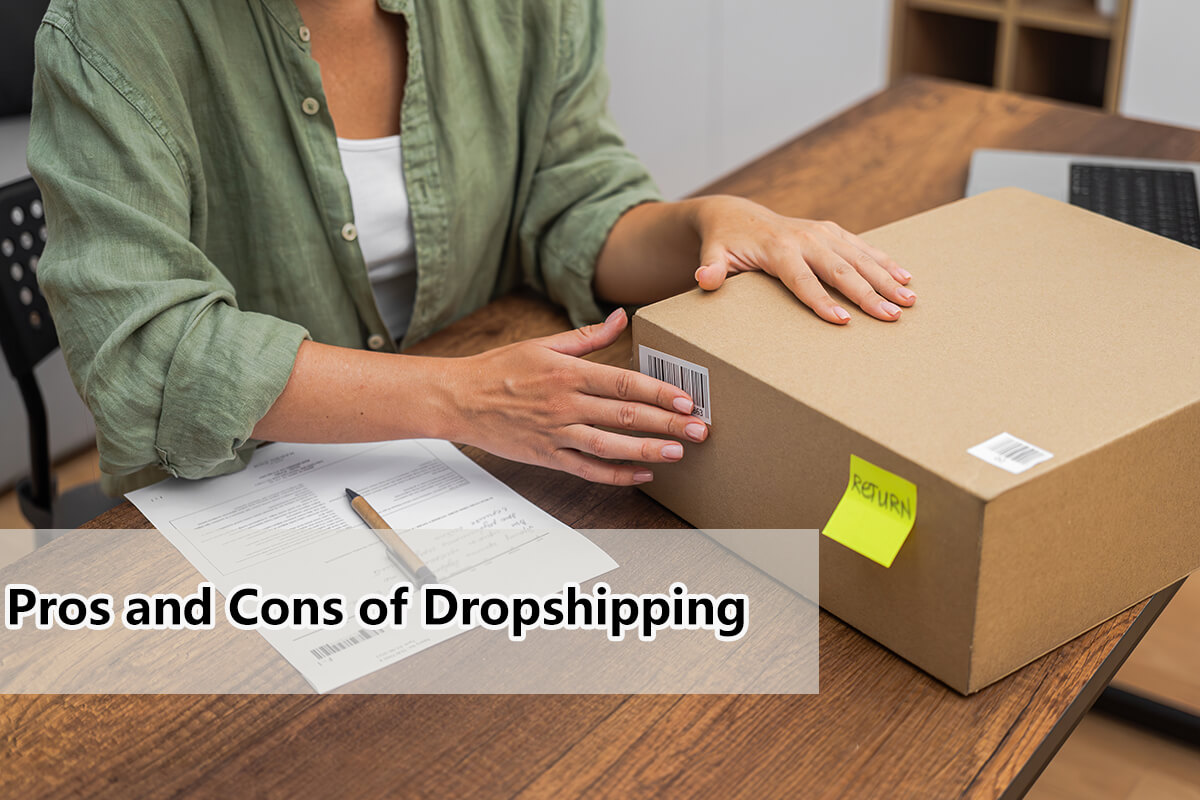Understanding the Pros and Cons of Dropshipping

If you’re seeking a business that requires minimal capital, you may have come across dropshipping. Dropshipping is a business model where you sell products without the need to keep them in stock.
Here’s how dropshipping works: you promote items from other vendors or suppliers, and when a customer places an order with you, you notify your dropshipping supplier. They handle the packing and shipping directly to the customer. And in return, you receive a percentage of the sale as your income. Sounds pretty simple, right?
While dropshipping seems like an attractive option for those with limited funds, it’s essential to thoroughly evaluate the pros and cons of dropshipping to determine if it’s truly the right fit for you.
The Pros of Dropshipping
Dropshipping offers numerous advantages, and according to foundr, it is one of the most profitable businesses to start in 2024! To assess whether dropshipping is a worthwhile endeavor, let’s explore its key benefits.
1. No need to stock up on items upfront
One of the pros of dropshipping is that you don’t have to fork out cash to buy and store products. You know how some businesses end up with losses because they stock up on items that don’t really sell well? But with dropshipping, you can test the waters without spending a dime upfront. You’re free to try out different products to see what clicks with your customers without the financial gamble.
2. Doesn’t require storage space
With dropshipping, you can avoid the headache of turning your home into a storage nightmare filled with products. We’ve seen small e-commerce businesses go all out, basically transforming their homes into warehouses!
Just picture it: buying products upfront, and suddenly, you can’t live comfortably in your own space because it’s packed with inventory. The advantage of dropshipping is that you don’t need to deplete your bank account to construct an additional storage room or lease storage space from third-party providers.

3. Lower overhead costs
Compared to traditional brick-and-mortar stores, dropshipping offers the advantage of lower overhead costs. This is because you’re not required to purchase products upfront or rent storage space.
Your primary expenditures are typically directed toward e-commerce platform fees, domain and hosting (if you want to have your own website), marketing and advertising costs, customer service, and taxes. Moreover, if you choose to manage marketing and customer service tasks on your own, you can further reduce your overall overhead costs.
4. Easier to get started
Unlike other businesses that require a ton of setup, such as sourcing products, securing an ideal physical store location, finding storage space, hiring staff, and building marketing channels, dropshipping lets you start more quickly, even on your own. To begin dropshipping, all you need to do is find a reliable supplier like Sup Dropshipping, create your online store on your preferred platforms, such as Amazon, eBay, or Etsy, and set up your social media for marketing.
If you team up with Sup Dropshipping, we can assist in automating your dropshipping business. We offer dropshipping software that you can easily integrate with your e-commerce store, eliminating the need to hire extra help. Some vendors and suppliers permit dropshipping but lack an automated tool like ours. They only rely on text, emails, or social media messages from their dropshippers for order notifications, which can lead to order processing and shipment delays. With our system, we guarantee more efficient order processing.
5. Lesser things to do and worry about
For business owners overseeing physical product inventory, we’re sure there’s a lot on your plate. You must keep your storage room clean, watch out for pesky pests, ensure the integrity of your stored products, and deal with packing and shipping products to your customers. Doing these tasks definitely consumes a lot of valuable time and resources.
However, if you opt for the dropshipping business model, these concerns are no longer on your shoulders. Your dropshipping supplier takes over the tasks of storage, packing, and shipping. With these responsibilities off your hands, you can concentrate on consistently marketing your products to increase sales.
6. Work anywhere
Traditional businesses often demand on-site work, especially when prompt shipping is necessary upon receiving orders. In contrast, a dropshipping business offers the flexibility to work from virtually anywhere – be it your home, a coffee shop, or any location of your preference.
The advantage of dropshipping is that you can confirm orders from your customers as long as you have a laptop or even just a smartphone with WiFi. This level of convenience enables entrepreneurs to manage their businesses seamlessly while enjoying the freedom to choose their workspace.

7. Easily expand your business without towering costs
If your biz is doing well, you can quickly grow your dropshipping business without spending a ton. It’s much simpler than traditional businesses that have to construct new branches, hire more people, and buy more products.
With dropshipping, you might just need to up your subscription fees a bit with your dropshipping supplier, especially when you want to add different types of items to your product line. And this is definitely way cheaper than all the high costs traditional businesses face when growing.
The Cons of Dropshipping (Plus Solutions)
The advantages of dropshipping are undoubtedly encouraging, prompting you to get started right away. However, like any other type of business, dropshipping has disadvantages and flaws.
1. Your products may look like everyone else’s
When you rely on dropshipping suppliers for product images, there’s a risk that your products may look identical to those of other sellers. Since many dropshippers share the same product photos, your offerings may lack uniqueness.
Solution:
You have the option to purchase each item you sell from your dropshipping supplier and take your own photos. Alternatively, some dropshipping suppliers, including Sup Dropshipping, offer brand-building services. If you want your products to stand out, consider our brand-building service, where we customize your items before shipping. This includes adding your brand logo and tags, creating unique packaging, and providing customized product photography and videos.
2. Challenges in addressing customer queries
Managing customer inquiries may be a hurdle when you don’t own the products you sell, as you lack firsthand experience with them. For example, if you’re selling a bag and a customer asks about its number of inner pockets, you might not know it since some dropshipping suppliers don’t always provide comprehensive product details.
Solution:
While you can directly ask your dropshipping supplier, their response time may be prolonged. Alternatively, you can search for similar products online, read descriptions from other sellers, and go through reviews to gather the necessary information and address customer queries effectively.

3. Unable to take actual product photos if the customer asks for it
Many buyers encounter issues such as receiving incomplete or damaged orders, leading them to request actual photos before shipping. Unfortunately, dropshipping presents a challenge in this aspect, as you can’t send real-time images of the products.
Solution:
Ask your dropshipping supplier to send actual photos so you can share them with your customer. Another solution is to be transparent with your customer about running a dropshipping model and not having physical access to the items. Then, assure your customer that you will refund them in case of any shortages or damages.
4. Limited control over shipment times
Having your product inventory allows you to ship items immediately after a customer places an order. However, in dropshipping, the shipment timing is determined by your dropshipping supplier.
Solution:
Seek out dropshipping suppliers known for fast shipping. Typically, the duration is between 3-15 days for international shipments. Adjust your e-commerce store’s shipment details to align with your supplier’s shipping times. If a customer expresses concern about slow shipment, provide them with the expected range of days within which they can anticipate receiving their order.
5. Lack of quality control
Because your dropshipping supplier handles the shipment of your customer’s orders, you can’t personally inspect the quality of the products being sent. If your dropshipping supplier ships damaged items, the customer’s dissatisfaction is directed at your e-commerce store, not them. And this has the potential to tarnish your store’s reputation.
Solution:
Choose a dropshipping supplier that incorporates quality inspection into their services. At Sup Dropshipping, our fulfillment services include thorough product inspection before shipping, ensuring satisfaction for both our dropshippers and their customers.
6. No tracking of inventory
In dropshipping, you can’t always be sure if your supplier has the items in stock. Imagine listing something available in your store, and then a customer orders it, only to find out your dropshipping supplier doesn’t have it. This leads to canceled orders, and if it happens a lot, some online stores may penalize you or even suspend your shop.
Solution:
When choosing a dropshipping supplier, opt for one based in China. Many global dropshipping suppliers source their items from China since it’s known as the “World’s Factory.” By directly choosing a China-based dropshipping supplier like Sup Dropshipping, the risk of stockouts is significantly reduced.
7. Lower profit margin
Dropshipping suppliers typically don’t extend discounts to dropshippers since they don’t make bulk purchases. This limitation makes it challenging to mark up prices significantly and enjoy the same privileges and discounts as bulk buyers.
Solution:
Adapting to lower profit margins in dropshipping is a reality, given the absence of bulk-buying advantages. To enhance your earnings, consider selling niche products with less competition, allowing for higher pricing. Implementing upselling or cross-selling strategies and offering time-limited promotions can also increase revenue. While you may not enjoy the same profit margins as bulk buyers, strategic approaches can help optimize your earnings within the dropshipping model.

Frequently Asked Questions (FAQs)
1. Is dropshipping worth it?
Yes, dropshipping is still a profitable business. Plus, it’s a business model projected to grow in the upcoming years. Analysts forecast the dropshipping market to reach $301.11 billion in 2024, $372.47 billion in 2025, and $476.1 billion in 2026.
2. How do I start a dropshipping business for beginners?
First, consider what you want to sell and identify your target audience. Then, search for a dropshipping supplier. Once that’s done, create your store name and design a logo. Set up your store’s social media accounts and integrate your dropshipping business with your preferred e-commerce platforms. List your products and implement a robust marketing strategy. Optionally, you can build an e-commerce website to make your dropshipping business look more trustworthy and professional. You can also check out our written guide: “Dropshipping for Beginners: Building a Successful Online Store in 3 Steps.”
3. Can I start dropshipping for free?
Yes, you can start dropshipping for free. It’s important to note that dropshipping isn’t limited to global operations. Local dropshipping suppliers also exist. Some local suppliers allow you to use and grab their product photos for marketing and selling on social media without any cost. However, if you sign up your dropshipping business on e-commerce platforms like eBay, they may charge you for simply listing a product, even if you haven’t made a sale yet.
4. How do I find dropshipping suppliers?
There are many ways to find dropshipping suppliers. These include utilizing online supplier directories, contacting manufacturers directly, joining relevant online forums and groups, researching competitors, participating in trade shows, and more. For more details, check out “How Can You Find a Good Dropshipping Supplier in China?”
Summary
Dropshipping presents an enticing business model due to its low capital requirements. But here’s what you need to know — only 10-20% of dropshippers make it big. Dropshipping isn’t exactly a get-rich-quick scheme as what others blindly believe. So, before you jump in, weigh the pros and cons of dropshipping to see if it’s really the right business for you.
For those eager to kickstart their dropshipping journey, consider Sup Dropshipping as your reliable supplier. Our dropshipping platform is available for free, plus we have premium subscriptions. You can easily integrate our dropshipping software into various e-commerce platforms like Amazon, eBay, Etsy, Lazada, Shopee, PrestaShop, and more, so you can automate your dropshipping operations. If you have any inquiries, feel free to reach out to us.
About the Author

Jack Han
Jack is a SEO manager and blog writer at Sup Dropshipping. He holds an MA in Linguistics and Education. He has over 10 years experience in E-commerce, and 5 years of experience in SEO. Jack is an enthusiast to share his recent knowledge learnt from peer experts in the industry.





Leave a Reply